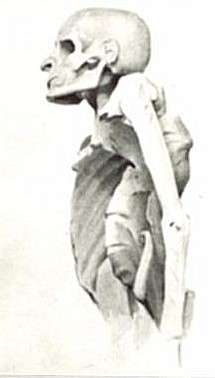Pott disease
| Pott disease | |
|---|---|
| Classification and external resources | |
| Specialty | rheumatology |
| ICD-10 | A18.0, M49.0 |
| ICD-9-CM | 015.0 |
| MeSH | D014399 |

Pott disease or Pott's disease is a form of tuberculosis that occurs outside the lungs whereby disease is seen in the vertebrae.[1] Tuberculosis can affect several tissues outside of the lungs including the spine, a kind of tuberculous arthritis of the intervertebral joints. The disease is named after Percivall Pott (1714–1788), a British surgeon. The lower thoracic and upper lumbar vertebrae are the areas of the spine most often affected. The formal name for the disease is tuberculous spondylitis and it is most commonly localized in the thoracic portion of the spine.
Pott’s disease results from haematogenous spread of tuberculosis from other sites, often the lungs. The infection then spreads from two adjacent vertebrae into the adjoining intervertebral disc space. If only one vertebra is affected, the disc is normal, but if two are involved, the disc, which is avascular, cannot receive nutrients and collapses. In a process called caseous necrosis the disc tissue dies leading to vertebral narrowing and eventually to vertebral collapse and spinal damage. A dry soft tissue mass often forms and superinfection is rare.
Diagnosis
- – CBC: leukocytosis
- – Elevated erythrocyte sedimentation rate: >100 mm/h
- – Tuberculin skin test (purified protein derivative [PPD]) results are positive in 84–95% of patients with Pott disease who are not infected with HIV.
 A girl from Oklahoma, who has been affected by bone tuberculosis, 1935
A girl from Oklahoma, who has been affected by bone tuberculosis, 1935
- Radiographs of the spine
- – Radiographic changes associated with Pott disease present relatively late. The following are radiographic changes characteristic of spinal tuberculosis on plain radiography:
- Lytic destruction of anterior portion of vertebral body
- Increased anterior wedging
- Collapse of vertebral body
- Reactive sclerosis on a progressive lytic process
- Enlarged psoas shadow with or without calcification
- – Additional radiographic findings may include the following:
- Vertebral end plates are osteoporotic.
- Intervertebral disks may be shrunk or destroyed.
- Vertebral bodies show variable degrees of destruction.
- Fusiform paravertebral shadows suggest abscess formation.
- Bone lesions may occur at more than one level.
- Bone scan
- CT of the spine
- Bone biopsy
- MRI
Prevention
Controlling the spread of tuberculosis infection can prevent tuberculous spondylitis and arthritis. Patients who have a positive PPD test (but not active tuberculosis) may decrease their risk by properly taking medicines to prevent tuberculosis. To effectively treat tuberculosis, it is crucial that patients take their medications exactly as prescribed.
Management
- Non-operative – antituberculous drugs
- Analgesics
- Immobilization of the spine region using different types of braces and collars
- Surgery may be necessary, especially to drain spinal abscesses or debride bony lesions fully or to stabilize the spine. A 2007 review found just two randomized clinical trials with at least one year-follow up found which compared chemotherapy plus surgery with chemotherapy alone for treating people diagnosed with active tuberculosis of the spine. As such there is no high grade evidence but the results of this study indicates that surgery should not be recommended routinely and clinicians have to selectively judge and decide on which patients to operate.[2]
- Thoracic spinal fusion with or without instrumentation as a last resort
- Physical therapy for pain-relieving modalities, postural education and teaching a home exercise program for strength and flexibility
Prognosis
- Vertebral collapse resulting in kyphosis
- Spinal cord compression
- Sinus formation
- Paraplegia (so called Pott's paraplegia)
Cultural references
- In Pulitzer Prize-winning novel His Family, young Johnny Geer is suffering from a terminal case of Pott's Disease.
- The Passionist saint Gemma Galgani suffered from tuberculosis of the spine.
- The fictional Hunchback of Notre Dame had a gibbus deformity (humpback) similar to the type caused by tuberculosis.
- In Henrik Ibsen's play "A Doll's House," Dr. Rank suffers from "consumption of the spine."
- Jocelin, the Dean who wanted a spire on his cathedral in William Golding's "The Spire" probably suffered and died as a result of this disease.
- English poets Alexander Pope and William Ernest Henley both suffered from Pott's disease.
- Anna Roosevelt Cowles, sister of president Theodore Roosevelt, suffered from Pott's disease.
- Søren Kierkegaard may have died from Pott disease according to professor Kaare Weismann and literature scientist Jens Staubrand[3]
- Chick Webb, swing era drummer and band leader, was afflicted with tuberculosis of the spine as a child, which left him hunchbacked.
- The Sicilian mafia boss Luciano Leggio had Pott's disease and wore a brace.
- Morton, the railroad magnate in Once Upon a Time in the West, suffers from the disease and needs crutches to walk.
- Writer Max Blecher had Pott's disease.
- Marxist thinker and Communist leader Antonio Gramsci suffered from Pott's disease, probably due to the bad conditions of his incarceration in fascist Italy during the 1930s.
- Italian writer, poet and philosopher Giacomo Leopardi suffered from this disease.
- It features prominently in the book This Is a Soul, which chronicles the work of American physician Rick Hodes in Ethiopia.
- Imogen in the novella "The Princess with the Golden Hair," part of Memoirs of Hecate County by Edmund Wilson (1946) has Pott's disease.
- Jane Addams, social activist and Nobel Peace Prize winner, had Pott's disease.
- Gavrilo Princip, who assassinated Archduke Franz Ferdinand of Austria, leading to World War I, died in prison of bone tuberculosis.
- Saint Bernadette of Lourdes had tuberculosis of the bone in her right knee
References
- ↑ "Extrapulmonary Tuberculosis". TB Symptoms. 2013-01-18. Retrieved 2013-07-11.
- ↑ Jutte PC, van Loenhout-Rooyackers JH. Routine surgery in addition to chemotherapy for treating spinal tuberculosis. Cochrane Database of Systematic Reviews 2006, Issue 1. Art. No.: CD004532. DOI: 10.1002/14651858.CD004532.pub2. http://onlinelibrary.wiley.com/doi/10.1002/14651858.CD004532.pub2/abstract
- ↑ Krasnik, Benjamin (2013). "Kierkegaard døde formentlig af Potts sygdom" (in Danish). Kristeligt Dagblad. Retrieved 2016-10-02.
External links
- Pott Disease — Tuberculous Spondylitis (medical article with MRI picture), eMedicine.
- "Tuberculous arthritis", MedlinePlus, USA: NIH. Public domain.
- Pott disease
- Pott's Disease of the Thoracic Spine